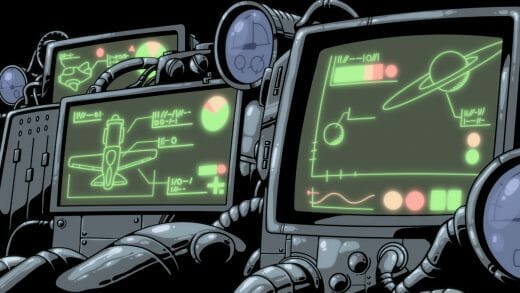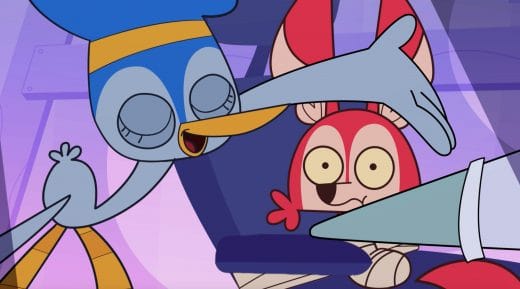
In Jacob Birmingham’s directorial debut The Legend of Bill, a duck takes on a fox in a high-stakes desert race. The catch? Bill the Duck doesn’t have a truck suitable for racing through the desert. All he has is his Ford Bronco. Taking inspiration from animation legends like Genndy Tartakovsky and Chuck Jones, as well as live-action directors like James Mangold, The Legend of Bill balances wacky humour and the life-or-death stakes of off-road racing.
The Legend of Bill was produced entirely by Lipscomb’s Creative Entertainment Arts students. It won the “Best Sound Design” and “Best Original Score” award at Lipscomb University’s 5-Minute Film Festival. The short film integrates 2D characters with 3D vehicles. Birmingham is currently in the process of developing The Legend of Bill into an animated series.
Read on to learn what Jacob Birmingham (director) and Michael Stephens (producer) had to say about wrangling multiple software tools and animation techniques along with student schedules in order to bring The Legend of Bill to the screen.
How would you describe your roles on The Legend of Bill? And who are the other key contributors?
Jacob: I’m the director and Michael is our producer. Early on, I took the different grads aside and was like, “Hey, I think you’re really good at this. Would you be interested in being in this role for this film?” And one of the first ones was asking Michael to be our producer.
I told him at the outset that I was used to doing projects pretty much by myself. or with a small team at a previous job. It was really hard for me to take my producer hat and put it down. I wanted to try just being a director, a visionary that goes crazy and just free falls off the cliff.
And Michael was great and brilliant and kept us organized all the way through.
He has a background in games, so he brought this 3D knowledge to the project. And a lot of our undergrads brought really strong 3D talent to the film as well. Going into it, we knew that we had some strong 2D grads and undergrads. We didn’t know who we were going to get until like right before the fall semester started.
We’d actually boarded a film that could be completely executed in 2D because we weren’t sure if we were going to have 3D capability with the crew that we had. And at the last minute, we onboarded all those 3D kids.
Michael: Jacob had the like vision. And so my job as the producer is like, “How do we get that done in the weeks that we had in class?” It was a lot of problem identification. I didn’t necessarily solve those problems, but a lot of my job was identifying them with enough time to solve them and make sure that people were working on them.
Ideally you have a full team time, but it was one class for all the students. So there was lot of managing spreadsheets, just making sure this thing got done.
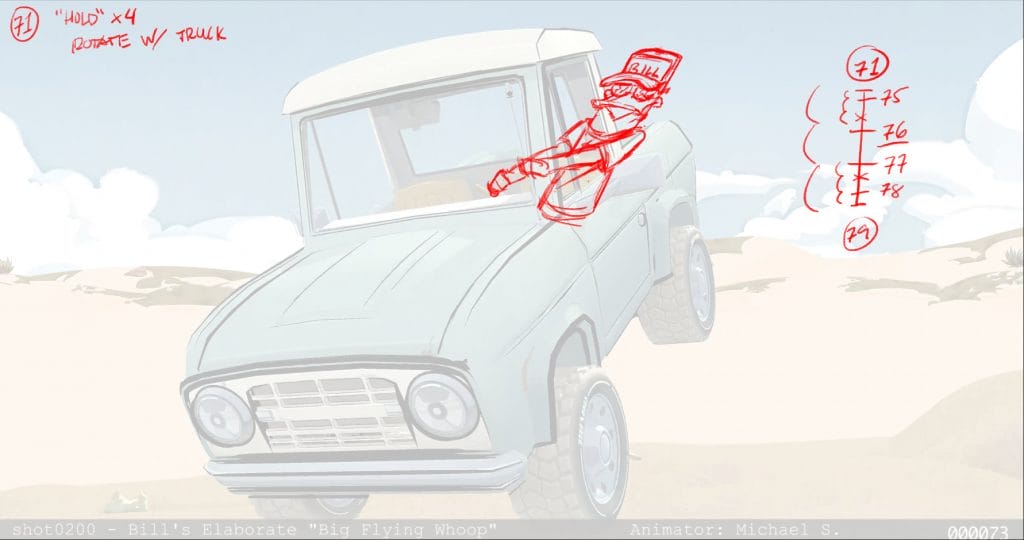
The action and the comedy really shine in The Legend of Bill, but the trucks steal the show. How important was it to get the Bronco and the F-150 right?
Jacob: Pretty important. We worked on those for the duration of the summer. So coming in, a lot of things weren’t ready but the designs of what the trucks were supposed to look like were pretty locked down.
That would have been the work of our production designer, Kristen Breshears, who also goes by Kay. She was fantastic. She pushed it super cartoony. I had a very realistic way of drawing the trucks, which I knew was not pushed enough. She pushed it into super cartoon.
Where we landed is pushing the design and the action and everything else to a Looney Tunes level and then reserving it just a little bit, so it has that cartoon pushed aesthetic feel but it still feels grounded. Because we have a lot of comedy in the film but we also have a lot of drama in the film. So we needed those stakes to feel real.
We didn’t want it to feel like the car’s made out of rubber and everybody’s safe all the time, you know? It was very important to me because a lot of this was inspired by seeing some trophy truck desert racers.
The suspension travel on these vehicles is just insane. I mean they go over these huge hills at high velocity and you’re just watching all this dust go everywhere. And there’s so much physics going on there, and that’s exciting. What would it look like to put a character inside of that and have all that work together?
These cars were selected as extensions of the characters. Initially I had built in a truck that was a little bit more suped-up and a little bit more powerful. And then it was like, “Well, he needs to be an ‘underduck.’ He needs to be in something that looks like it can’t beat the other thing.”
My mom and dad had a Bronco when I was growing up, which is a much bigger vehicle. I remember my dad saying something about it being on a truck body. So I knew I wanted this to be a truck race, and I was like, “I wonder if there was ever a Bronco truck?”
I found out that the very first release of the Bronco had three models. One of them was a roadster, one of them was the classic one that we know, which has the boxy back on it, and then they had one that was a half-cab, where the back is chopped off and it looks like a little truck. And it actually looks like a duck!
I just thought that was so funny. I was like, “Well, that’s definitely his car. Because you put that up next to something else and it just looks tiny. And the Bronco is not a small car but proportionally it just had this nice feel to it.
It wasn’t until I selected that vehicle and I was working on designs with Kay that I found out that there is somebody that’s named Bill who is highly involved in the origins of that vehicle. It was one of the first vehicles to win what later became the Baja 1000, which was where some of the original source material came from.
Then when you’re in Texas, especially in the Dallas area, and there’s flat roads everywhere, it just showcases vehicles really well when you’re just driving next to them. I remember when F-150 Raptors started getting popular, I started casually referring them to my kids as the catamaran of the road because they took up the whole lane.
I looked up the specs of all the trucks and this truck is actually several inches wider than a normal F-150. And lot of the vehicles on the market today and being marketed today are advertising as Baja-tested. Meaning that they have been in Baja, they’ve driven on desert roads, and now we’re going to sell the consumer a truck that can do really cool things.
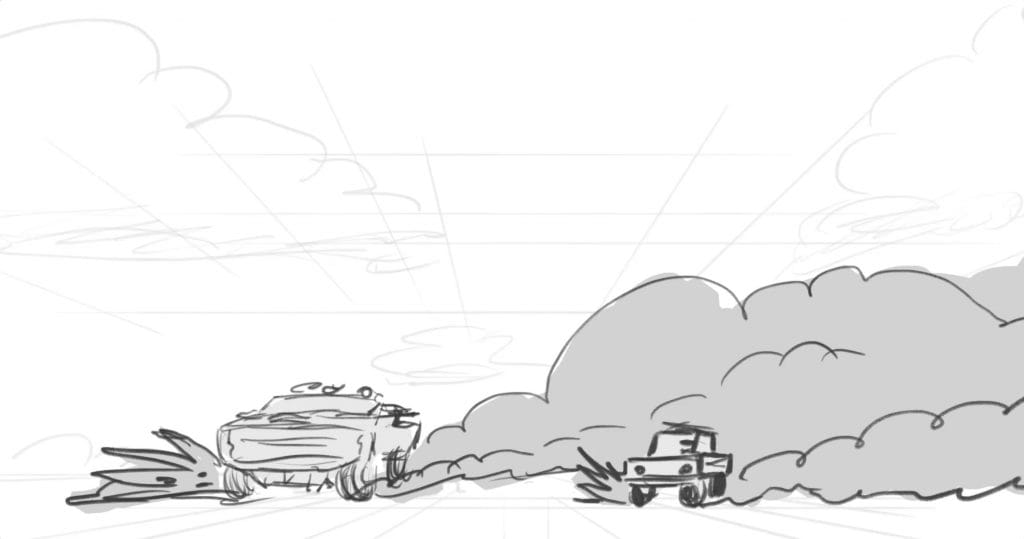
I know that Chuck Jones, Genndy Tartakovsky and James Mangold were all influences on The Legend of Bill. How did these styles come together?
Jacob: I have a fascination with Chuck Jones animation for sure. I love the comedy, the humor, the timing. I’ve studied it quite a bit, read his books and his approach. Also his background designer, Maurice Noble, has a book which is fantastic, “A Noble Approach.”
So I’ve probably done enough study that it’s just become a part of my DNA.
And I don’t know how many times I watched Ford v Ferrari.That’s why James Mangold is listed as an influence. There was a drama to the storytelling that I loved. It helps that the main character is from Texas. And so that speaks to me in a lot of Texas ways. But there was a tone to that film that I really liked.
And I pretty much follow all of Genny Tartakovsky’s work. Samurai Jack was probably the most impactful out of all that. And then there was that Star Wars: Clone Wars series. They were in three-minute chunks, which I just rewatched recently, and they’re still so fantastic.
Listening to him talk about how he will do animation and then snap into a pose [was a big influence]. And additionally, his sense of action and pacing, and how he’s not afraid to go slow, and just hold on a shot, and just let you feel that shot. /there’s a lot of action sensibilities that come from that as well.
In the writing process, the big discovery when I was researching was researching car crashes, and rescue equipment, and all that stuff. Vehicle safety, just all the way down the line, when you get into the automotive rabbit hole.
And at some point, it became very clear to me that the stakes of racing are not winning and losing, they’re life and death. So I was like, well, I don’t want to shortchange those. Those are like the best stakes that we could have. I think that that tension is what’s going to drive the narrative of this story and really give it the tooth that it needs.
So you’ve got this very, these characters that feel like they could lean into a very loony place, but they’re played straight, and they’re played serious, and they care about what they’re doing. And then as we find out, they care about each other.
I was thinking particularly about Tartakovsky, because I was very big on The Powerpuff Girls growing up.
Jacob: Oh, such a good show. It’s amazing.
The action is very unique to his work. So seeing that shot in The Legend of Bill of Bill’s grandmother in the stands watching the explosion happen – the shot that holds for what feels like two seconds too long, until it becomes hilarious – I thought, “That’s the Tartakovsky, right there.”
Jacob: That’s my favorite in-the-room audience response. Because I don’t really know what I’m going to get.
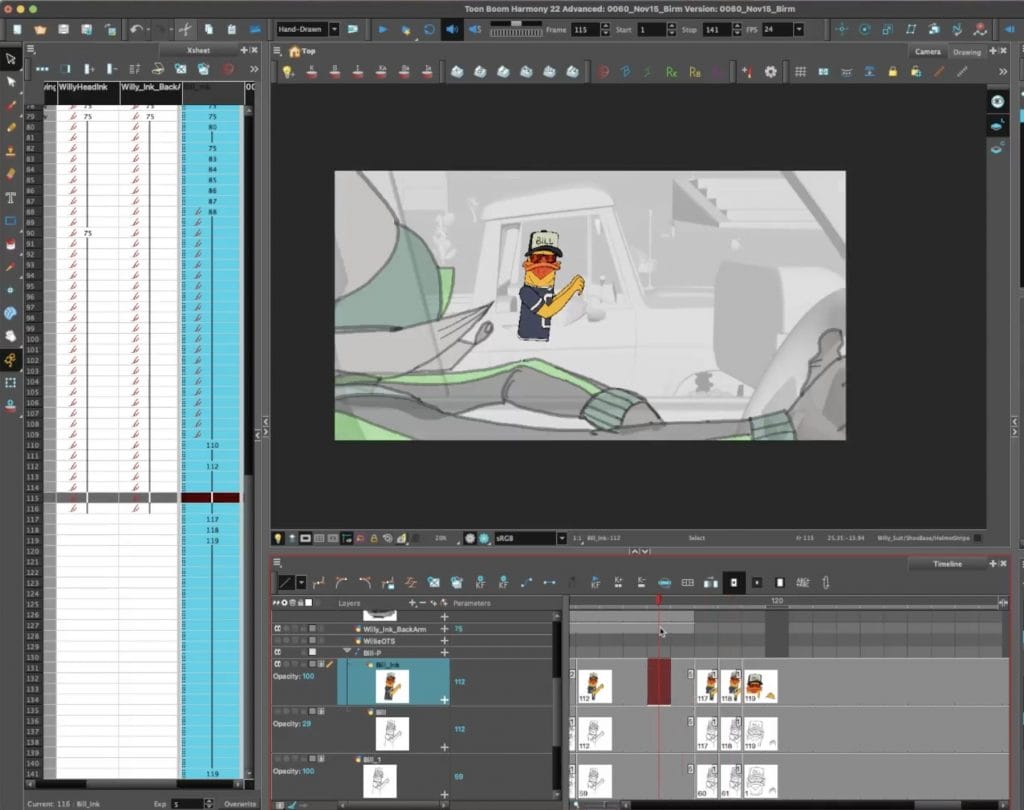
The Legend of Bill uses both 2D and 3D animation. What was your experience like using Harmony on a hybrid production?
Michael: Harmony is all the 2D side of it. For the 3D side of it, some people preferred Blender, some people preferred Maya. I believe everything was rigged in Maya though, and we did our rendering in Maya.
Maya is like the off ramp for the 3D side, Toon Boom Harmony is the off ramp for the 2D side. And then it was Jacob here doing a lot of compositing and After Effects to put it all together.
Jacob: Both of those programs give you a tremendous amount of control of what you can output. So we were probably a little greedy in our output. We had a lot of data that needed to be wrangled together to composite what both Maya and Toon Boom Harmony were able to produce for us.
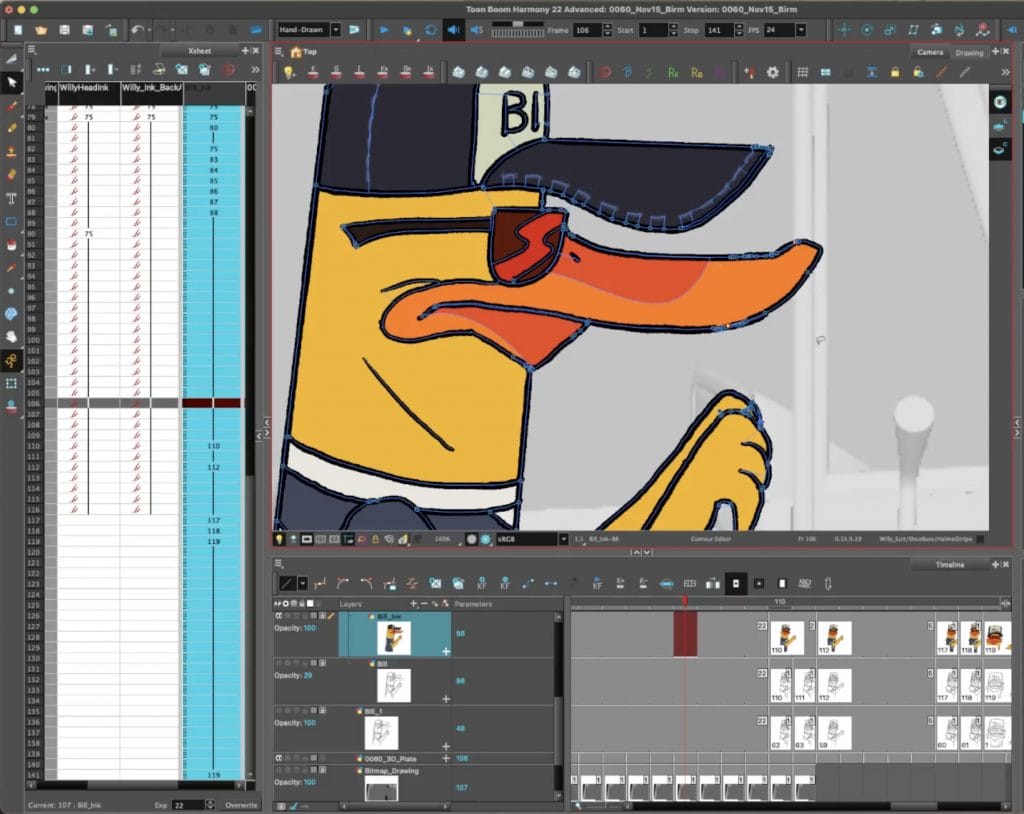
Michael: Yeah, and on the 2D side and the pre-production and stuff, obviously we used Storyboard Pro for our boards. And then for animation, we were in Harmony. And our school has premium accounts loaded up on all the machines and I have an advanced account on my own computer. So we basically just did it traditionally. It was just rough animation.
It wasn’t like one person going in and keying everything. Each animator got their own shot and that was true of our CG shots as well. And just about every shot was touched by at least two animators because there would have been the truck and the 2D character inside the truck.
Jacob: A few people did that through and through for the whole thing, but for the most part it was that. And Granny’s wheelchair is also a 3D vehicle. That’s her vehicle. That shot was three animators because it was me animating Bill, and then our CG lead Mitchel Kline animating the wheelchair, and then our other 3D animator John Willis animating Grandma.
And so that was that stack of things and that’s how we set up the whole film. That was a really cool teamwork project. It was also a very slow shot. We had another person come help us out in the following semester and she did all the paint on that shot.
So there were definitely a lot of hands on all these shots and I’m really proud of the crew for just the teamwork and being able to execute that stuff and be super flexible. I think we did find an economy of scale but we pretty much did every shot differently to some degree.
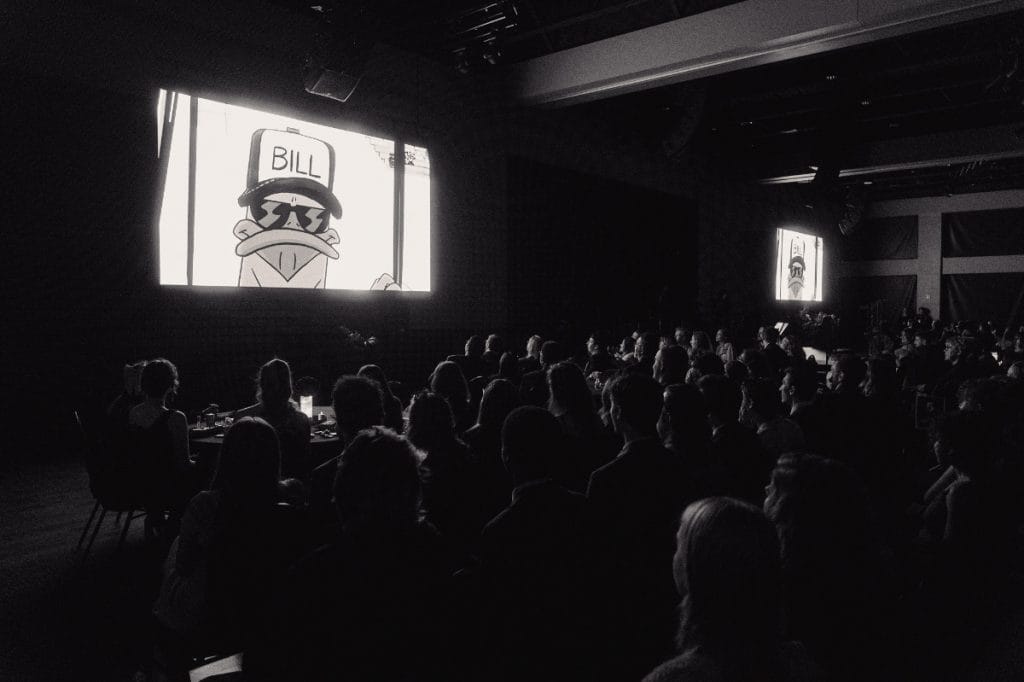
- Interested in seeing more? Find The Legend of Bill‘s behind-the-scenes footage on FilmFreeway and Instagram.
- Working towards your own thesis film? Students may be eligible for up to 84% off licenses for Harmony and Storyboard Pro.


